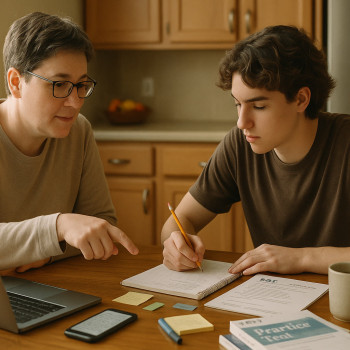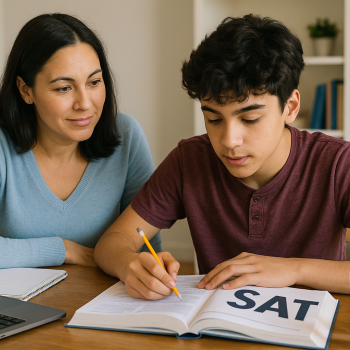Introduction: Why SAT Prep and Travel Can Really Coexist
Travel and studying often get treated like opposite lifestyles. One conjures images of airports, itineraries, and bright new places; the other suggests late-night review sessions, sticky notes, and mock tests. But for thousands of students who are athletes, performing artists, children of military families, exchange students, or simply adventurous, travel isn’t a pause button—it’s the backdrop for real life. The good news: the Digital SAT was built with modern students in mind, and with a few thoughtful systems you can turn your travel time into productive, low-stress prep time.
Mindset First: What Changes When You Study on the Move
Before we get tactical, let’s set expectations. Preparing for the SAT while traveling means embracing flexibility and simplicity. You’ll benefit from a mindset that values short, consistent practice over long, infrequent cram sessions. Think micro-wins: 20 focused minutes today, another review tomorrow on a flight, a practice section during a layover. These tiny increments add up remarkably fast.
Why flexibility beats perfection
- You will miss study sessions—plan for that and have quick recovery routines.
- Quality matters more than quantity: focused, distraction-free practice for 25–45 minutes yields more than unfocused hours in noisy spots.
- Use travel as an advantage: downtime on planes, trains, and waiting rooms is perfect for mental practice, review, or light drills.
Technology & Tools: Build a Reliable Mobile Test-Prep Toolkit
Digital SAT prep is naturally digital—so your device, software, and files are your lifelines. Pack a toolkit that is resilient to travel challenges (spotty Wi‑Fi, varying outlets, tight luggage). Here’s what to include and why.
Essentials to always have with you
- Primary device: laptop or tablet that supports the Bluebook testing environment and practice materials. If you plan to test on the same device, make sure it meets the approved specifications.
- Phone with practice apps: Official SAT practice on Khan Academy and any flashcard apps you like for short sessions.
- Portable charger and charging cables: aim for at least one compact battery pack (10,000 mAh+).
- Noise-cancelling headphones or good earbuds: priceless for focused practice in airports and cafés.
- Offline backups: download practice tests, PDFs, and study materials so you can work without internet.
Set up your digital workspace
When you’re traveling, your workspace changes constantly. Create a repeatable routine to set up anywhere:
- Find a flat surface and good light. Even small cafés or quiet corners of lounges work.
- Turn on focus mode or Do Not Disturb. Use a timer—25 or 45 minutes depending on whether you’re doing drills or a practice section.
- Open only the materials you need. Minimize tabs and apps to reduce cognitive switching.
Study Plans That Fit a Travel Schedule
There’s no single perfect study plan for traveling students, but there are patterns that reliably work. Below are three adaptable templates—pick one and tweak it to match your calendar.
1. The Frequent-Flier Micro Plan (Best for heavy travel)
- Daily: 20–30 minutes of targeted practice (vocab review, math formula flashcards, or a single reading passage).
- Weekly: One full practice section (or two short sections) on a weekend or during a long layover.
- Monthly: One full-length practice test in Bluebook when you have a solid block of time (3–4 hours). Review answers the next day.
2. The Road-Warrior Block Plan (Best for moderate but sustained travel)
- Daily: 30–60 minutes focusing on your weakest section.
- Every 2 weeks: Full digital practice test section (timed) and error log review.
- Every month: One full-length mock test under realistic conditions.
3. The Mission-Mode Burst Plan (Best when test date is near)
- Daily: 60–90 minutes with at least one timed section.
- Weekly: One full practice test; detailed analysis and drills to fix recurring mistakes.
- Travel hack: Use arrival or departure days for lighter tasks—flashcards, quick review, or passive learning like vocabulary podcasts.
How to Use Short Time Windows Effectively
When you only have 10–30 minutes—on a plane taxiing, in a taxi, or between meetings—use these high-impact activities:
- Targeted problem sets: pick questions that drill one concept until you see improvement.
- Flashcard reviews for formulas, grammar rules, and vocab.
- Mental math drills (no paper) to sharpen number sense and speed.
- Reading stamina: read a short dense paragraph and summarize it aloud to practice comprehension and synthesis.
Scheduling Around Time Zones and Erratic Days
Travel often means time-zone hopping. To preserve study efficacy:
- Anchor to local time rather than your home schedule after 24–48 hours; this helps with circadian rhythm.
- Use calendar blocks labeled “SAT focus” and honor them like appointments. Even short blocks are psychologically powerful.
- If you cross multiple time zones in one trip, give yourself at least one low-intensity study day to recover.
Practice Tests: When and How to Take Them While Traveling
Full-length practice tests are non-negotiable—especially for test-day comfort with the digital environment. But taking a four-hour test on the road requires planning.
Practical checklist before a practice test
- Choose a quiet, comfortable place with a reliable power source and internet if needed.
- Install and test the Bluebook practice environment in advance; run a short test preview to confirm everything works.
- Pack a snack, water, and anything else you need so you don’t pause mid-test.
- Block off recovery time afterward—reviewing mistakes is where the real gains happen.
| Practice Test Element | Recommended Frequency | Travel Considerations |
|---|---|---|
| Full-length Digital SAT (Bluebook) | Every 3–6 weeks | Reserve a quiet hotel room or library; ensure power and downloads are ready. |
| Timed Section (Reading or Math) | Weekly | Perfect for flights and long waits—requires 30–65 minutes. |
| Untimed Review and Error Analysis | After every practice | Can be done piecemeal: fix 5–10 mistakes each session while traveling. |
Smart Review: Turn Mistakes into an Engine for Growth
When you’re short on time, how you review matters more than how much you practice. Keep an error log—brief and mobile-friendly—and use a simple framework:
- Record the question type, the mistake, and the corrected approach.
- Tag errors by theme (e.g., ‘algebra setup’, ‘comma splice’, ‘evidence selection’).
- Schedule short drills that target your top three recurring error tags.
Packing Checklist: What to Bring for Test-Ready Travel
Pack like your prep depends on it—because it does. Here’s a compact checklist you can print and fold into your passport wallet.
- Primary device and charger, plus a backup battery.
- Printed copy of your test admission details and ID requirements; many testing centers require ID even for a digital test.
- Noise-cancelling headphones and a small notepad for scratch work.
- A list of quiet spaces near your travel route (library branches, co‑working spaces, hotel business centers).
- Comfort items for long practice tests: a water bottle, light snack, and a sweater.
Test Day When You’re Away from Home
Taking the SAT away from home adds logistical complexity, but most traveling students manage it smoothly with a small set of habits.
Two days before the test
- Confirm the testing location and travel time, leaving plenty of buffer for traffic or delays.
- Check device requirements and finalize Bluebook setup if you’ll use your device—install updates early.
- Sleep well. Prioritize rest over last-minute cramming.
On the test day
- Eat a balanced breakfast and stay hydrated.
- Arrive early to calm down and set up without rush.
- Run a short breathing exercise before you begin—20–30 seconds of focused breathing helps center attention.
Dealing with Unexpected Travel Disruptions
Missed flights, delayed trains, and lost luggage happen. Build resilience into your prep so disruptions don’t derail you.
- Have a backup plan for every major step: alternate study blocks, an emergency quiet spot list, and a compact offline study pack (paper or downloaded PDFs).
- If you miss a scheduled practice test, reschedule it within 48 hours and do a short diagnostic to keep momentum.
- When stress spikes, default to low-stakes activities—flashcards, review notes, listening to strategy podcasts—rather than forcing heavy study.
How Personalized Help Fits into a Travel Routine
Traveling students often benefit from outside structure. That’s where personalized tutoring can be a game changer. Rather than generic plans, a tutor who understands your travel rhythm can create tailored study blocks, assign bite-sized tasks for transit, and provide rapid feedback after practice tests.
For example, Sparkl’s personalized tutoring offers one-on-one guidance, tailored study plans, expert tutors, and AI-driven insights that adapt to your performance and schedule. If you’re juggling flights and rehearsals, a personalized plan from a tutor can tell you exactly what to do with a 20-minute layover so that practice remains purposeful instead of random.
Study Strategies That Travel Well
Not all study habits require a desk. Practice active recall, spaced repetition, and time awareness—these are portable, science-backed strategies that fit into any itinerary.
Active recall
Instead of re-reading, quiz yourself. Close the book and force your brain to retrieve formulas, grammar rules, or reading passage main ideas.
Spaced repetition
Use a flashcard app that spaces review sessions automatically. This is perfect for travel because it optimizes limited repetition windows across many days and time zones.
Timed practice
Simulate the pressure of the test by timing short sections on your device. This builds pacing instincts without needing a full test environment.
Real-World Examples: Students Who Nailed It on the Road
Consider a junior who tours with a competitive dance company three weekends per month. She turned each bus ride into a 30-minute study block using Khan Academy Practice custom playlists and audio explanations. Once per tour she booked a hotel room for a full Bluebook practice test and then shared her results with her tutor for targeted follow-up.
Another example: a student whose family moves seasonally used the BigFuture mobile app to track deadlines and scholarships while studying offline PDFs in remote locations. The steady short sessions built into his routine delivered steady score improvements without ever needing a strict home base.
Common Pitfalls and How to Avoid Them
- Overconfidence in short sessions—balance short practice with periodic longer sections.
- Unreliable tech—test devices and backups before you travel.
- Lack of review—always follow a practice section with a focused error analysis session within 48 hours.
Final 30-Day Sprint: How to Prepare When Time Is Tight and Travel Is Constant
If your test is within a month and you’ll be traveling frequently, focus on these priorities:
- Lock down one full practice test per week in Bluebook under realistic conditions.
- Every day: 30–60 minutes prioritizing weakest areas (guided by your error log).
- Weekly: 1–2 live tutoring sessions to diagnose persistent errors and practice test strategies. A personalized tutor can compress months of learning into weeks by focusing exactly where you need it.
- Night before test: light review only. Trust your practice and rest.
Quick Reference: Travel-Friendly SAT Prep Routine (Printable)
| When | Activity | Time |
|---|---|---|
| During flight or long transit | Timed reading or math section | 45–65 minutes |
| Layovers / waiting | Flashcards / vocabulary / quick math drills | 10–20 minutes |
| Evening wind-down | Error review from earlier practice | 20–30 minutes |
| Weekend or long stay | Full Bluebook practice test + detailed review | 3–4 hours + review time |
Conclusion: Travel Is Not a Barrier—It’s a Different Kind of Opportunity
Preparing for the Digital SAT while traveling demands planning, compact routines, and a healthy dose of flexibility. But it’s absolutely doable—and can even be energizing. You’ll learn to prioritize, to study smarter in short bursts, and to make every minute count. With the right tech setup, a simple error-log system, regular timed practice, and occasional tutoring for structure (personalized services like Sparkl’s one-on-one guidance, tailored study plans, and AI-driven insights can accelerate progress), you can arrive at test day confident and calm, even if your life is lived between terminals and train stations.
Remember: consistency beats intensity. Fifty minutes of intentional practice spread over three days will usually outperform one frantic five-hour session. Travel can teach you resilience, adaptability, and time awareness—qualities that will serve you well on test day and beyond.
Bonus: A Short Checklist to Pocket Now
- Download and test Bluebook and practice materials before you leave.
- Pack chargers, headphones, and offline study materials.
- Plan one full practice test during a longer stay; protect that time.
- Keep a concise error log and fix the top three recurring mistakes weekly.
- Consider a personalized tutor to tailor your plan to a travel-heavy schedule.
Safe travels, steady practice, and remember—your journey can be part of your success story. With a few habits and the right support, the Digital SAT becomes just another place where you can perform your best.














No Comments
Leave a comment Cancel